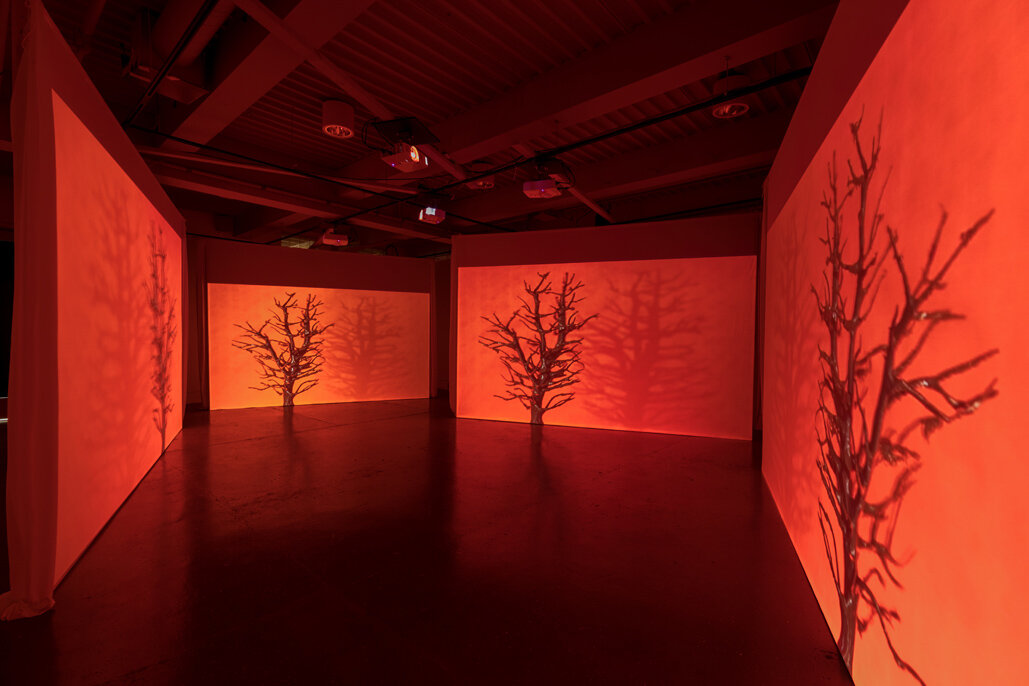Image by Yuri Akuney, courtesy of the artist.
In Fine Line: Check Check, the ubiquity of the self-doubting individual is inextricably linked to a mass culture marked by distrust of the very mass media which give it shape. Stepping into a space intersected by four large projection screens, the viewer was surrounded on all sides by a looping series of such vignettes screened, variously in fragments and in their entirety accompanied by a four-channel score from composer Don Macdonald. The events and the non-events in Check Check unfolded in a sequence that subtly choreographs the audience’s movement within and around the installation.
Johnston’s turn toward video for this piece stemmed from the consideration of an obsessive behaviour familiar to probably all viewers, namely our highly emotionally-charged relationship to screens and digital devices. The installation harnessed the knee-jerk nature of our conditioned responses to visual and auditory cues not only the pinging of a smartphone but even going back as far as silent film.
Image by Yuri Akuney, courtesy of the artist.
Ian Johnston is an artist living in the traditional territory of the Sinixt in Nelson, BC, Canada. Hi heritage is German, Jewish, Irish, English and he studied architecture at Algonquin College and Carleton University in Ottawa. Johnston also spent five years working at the Bauhaus Academy in post Berlin Wall, Dessau, Germany.
Johnston’s primary interest lies in the cycle of goods and he investigates, through site-specific sculptural and video installations, how things we consume populate our daily lives, define relationships we have with each other and ultimately define social structures. His practice is an extensive reflection on consumerism and the ensuing waste production.
For more information about Johnston’s work, visit his website.
The Shattering Uncertainty of a Safety Blanket // Interpretive Essay by Kitila Whiteman
Fine Line: Check Check was an installation of screens displaying various vignettes that led the mind’s eye to the periphery of multiple fine lines. Each scene had thoughtful detail that one can relate to on an abstract level. There is a specific story and theme behind every scene and yet also a chance for each member of the audience to create their own story during the experience. Visual and auditory cues provided a path for awareness to follow, yet the audience was simultaneously making constant interactive choices.
Image by Yuri Akuney, courtesy of the artist.
The accompanying music brought ripples of attention and emotion, creating a sense of harmonic balance as the viewer was guided amongst the four screens. Having a musical narrative paired with screens is instantly reminiscent of cinema culture. However, the multiple screens and unassigned viewing positions in Fine Line: Check Check disrupt traditional viewing practises. Instead of the person and the projection both inhabiting fixed positions, the relational dynamics between body and screen became more fluid and malleable.
Negotiating four screens at once leads to the necessary exploration of space, both physically and mentally. The vignettes had an abstract tension that fed into potential spatial interaction. When standing in the middle of the screens, there was always a screen just outside of our field of vision due to the spatial layout, which can create a slight tension. It is a constant possibility that, while absorbed in the action on one screen, there is something happening on another screen. Therefore, the body is more inclined to pace, move, twist and turn in response to the context of each vignette. Each scene leads to dichotomous emotional responses, inviting the viewer to conceptually explore seemingly distant themes at the same time.
Image by Yuri Akuney, courtesy of the artist.
Johnston spent years researching obsessive-compulsive disorder, frequently called the “doubting disease,” to inform this work. At the core of OCD, there is a constant flux between certainty and doubt. A thought of doubt arises that calls for a specific compulsive context before it can be resolved. Oscillation between certainty and doubt is a universal theme that everyone relates to on varying levels.
The vignettes played on a loop, making it possible to enter and exit at any moment of a very specific cyclical interplay of calm and apprehension. Interaction is a choice that is guided by sensory cues and spatial relation. While deciding what screens to watch, what sounds to hear, and what space to occupy, we are concurrently drawn in to a deeper mental reflection that continues even after leaving the gallery.




